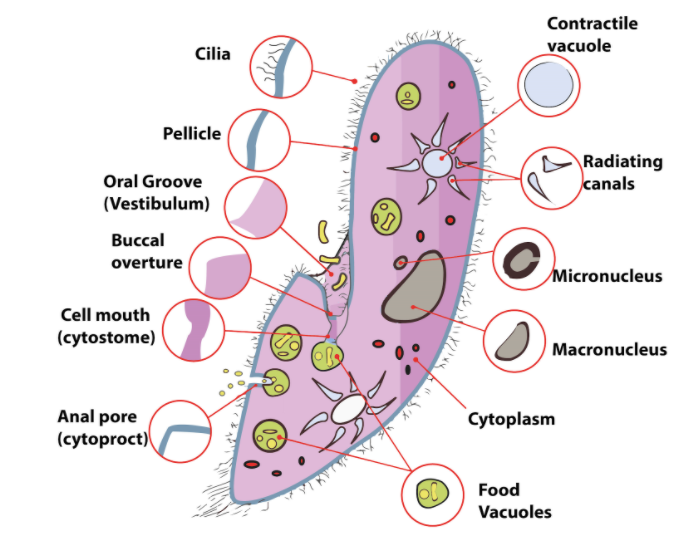
Draw a neat labelled diagram of Paramoecium
Answer
503.2k+ views
Hint: Paramecium is a genus of unicellular ciliated protozoa. They are characterized by the presence of thousands of cilia covering their body. They are found in freshwater, marine, and brackish water.
The coordinated movement of thousands of cilia propels paramecium. Paramecium can rotate around its axis and move in the reverse direction on encountering an obstacle.
The cell size varies from 50 µ to 300 µ. The cell is ovoid, slipper, or cigar-shaped.
Complete answer:

Parts of paramecium:
Pellicle: The cellular cytoplasm is enclosed in a pellicle. The pellicle is elastic and gives the cell its definite but changeable shape.
Cilia: They project from the depressions in the pellicle and cover the entire body surface. They are used for locomotion and taking nutrient-rich water inside the gullet.
Protoplasm: They are divided into outer ectoplasm and inner endoplasm, which is granular.
Paramecia contain at least two nuclei, micronuclei (one or more), and one macronucleus.
Micronuclei: They are diploid chromosomes and take part in the reproduction.
Macronuclei: They regulate all vital metabolic activities and growth. The macronucleus has multiple copies of the genome, i.e. polyploid.
Vacuoles: There are numerous food vacuoles present for digesting food
Contractile vacuoles: They are present and their number varies from species to species. They are required for osmoregulation and expel the additional absorbed water.
Oral groove: At the midpoint, there is an oral groove on the ventral side known as the vestibule. Food is drawn inside the cell due to the coordinated movement of cilia.
Cytostome: The oral groove opens in the mouth known as cytostome and to the gullet or pharynx.
Cytoproct: There is an anal pore present on the ventral surface in the posterior half of the cell known as cytoproct or cytopyge, which helps in egesting undigested food
Trichocysts: They are present and embedded in the ectoplasm. They are a defensive organ.
Endoplasmic granules: They reserve food. Some of the granules are secretory or excretory.
Note: They are mostly heterotrophic. They feed on bacteria, algae, yeast, and other microorganisms. They are holozoic. The food-laden water is drawn inside by the movement of cilia and it goes to the cytostome and to the gullet (cytopharynx).
The coordinated movement of thousands of cilia propels paramecium. Paramecium can rotate around its axis and move in the reverse direction on encountering an obstacle.
The cell size varies from 50 µ to 300 µ. The cell is ovoid, slipper, or cigar-shaped.
Complete answer:

Parts of paramecium:
Pellicle: The cellular cytoplasm is enclosed in a pellicle. The pellicle is elastic and gives the cell its definite but changeable shape.
Cilia: They project from the depressions in the pellicle and cover the entire body surface. They are used for locomotion and taking nutrient-rich water inside the gullet.
Protoplasm: They are divided into outer ectoplasm and inner endoplasm, which is granular.
Paramecia contain at least two nuclei, micronuclei (one or more), and one macronucleus.
Micronuclei: They are diploid chromosomes and take part in the reproduction.
Macronuclei: They regulate all vital metabolic activities and growth. The macronucleus has multiple copies of the genome, i.e. polyploid.
Vacuoles: There are numerous food vacuoles present for digesting food
Contractile vacuoles: They are present and their number varies from species to species. They are required for osmoregulation and expel the additional absorbed water.
Oral groove: At the midpoint, there is an oral groove on the ventral side known as the vestibule. Food is drawn inside the cell due to the coordinated movement of cilia.
Cytostome: The oral groove opens in the mouth known as cytostome and to the gullet or pharynx.
Cytoproct: There is an anal pore present on the ventral surface in the posterior half of the cell known as cytoproct or cytopyge, which helps in egesting undigested food
Trichocysts: They are present and embedded in the ectoplasm. They are a defensive organ.
Endoplasmic granules: They reserve food. Some of the granules are secretory or excretory.
Note: They are mostly heterotrophic. They feed on bacteria, algae, yeast, and other microorganisms. They are holozoic. The food-laden water is drawn inside by the movement of cilia and it goes to the cytostome and to the gullet (cytopharynx).
Recently Updated Pages
Master Class 11 Chemistry: Engaging Questions & Answers for Success

Which is the Longest Railway Platform in the world?

India Manned Space Mission Launch Target Month and Year 2025 Update

Which of the following pairs is correct?

The Turko-Afghan rule in India lasted for about?

Who wrote the novel "Pride and Prejudice"?

Trending doubts
What is meant by exothermic and endothermic reactions class 11 chemistry CBSE

Which type of resource is iron ore A Renewable B Biotic class 11 social science CBSE

10 examples of friction in our daily life

Differentiate between an exothermic and an endothermic class 11 chemistry CBSE

Difference Between Prokaryotic Cells and Eukaryotic Cells

1 Quintal is equal to a 110 kg b 10 kg c 100kg d 1000 class 11 physics CBSE




